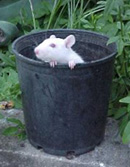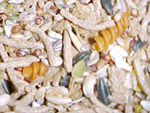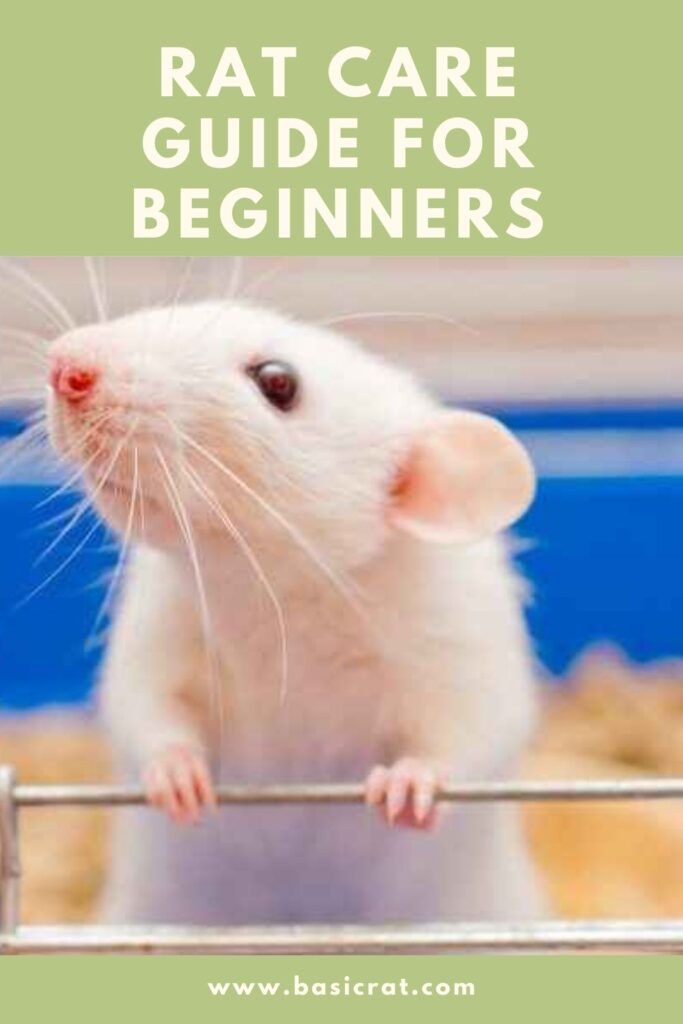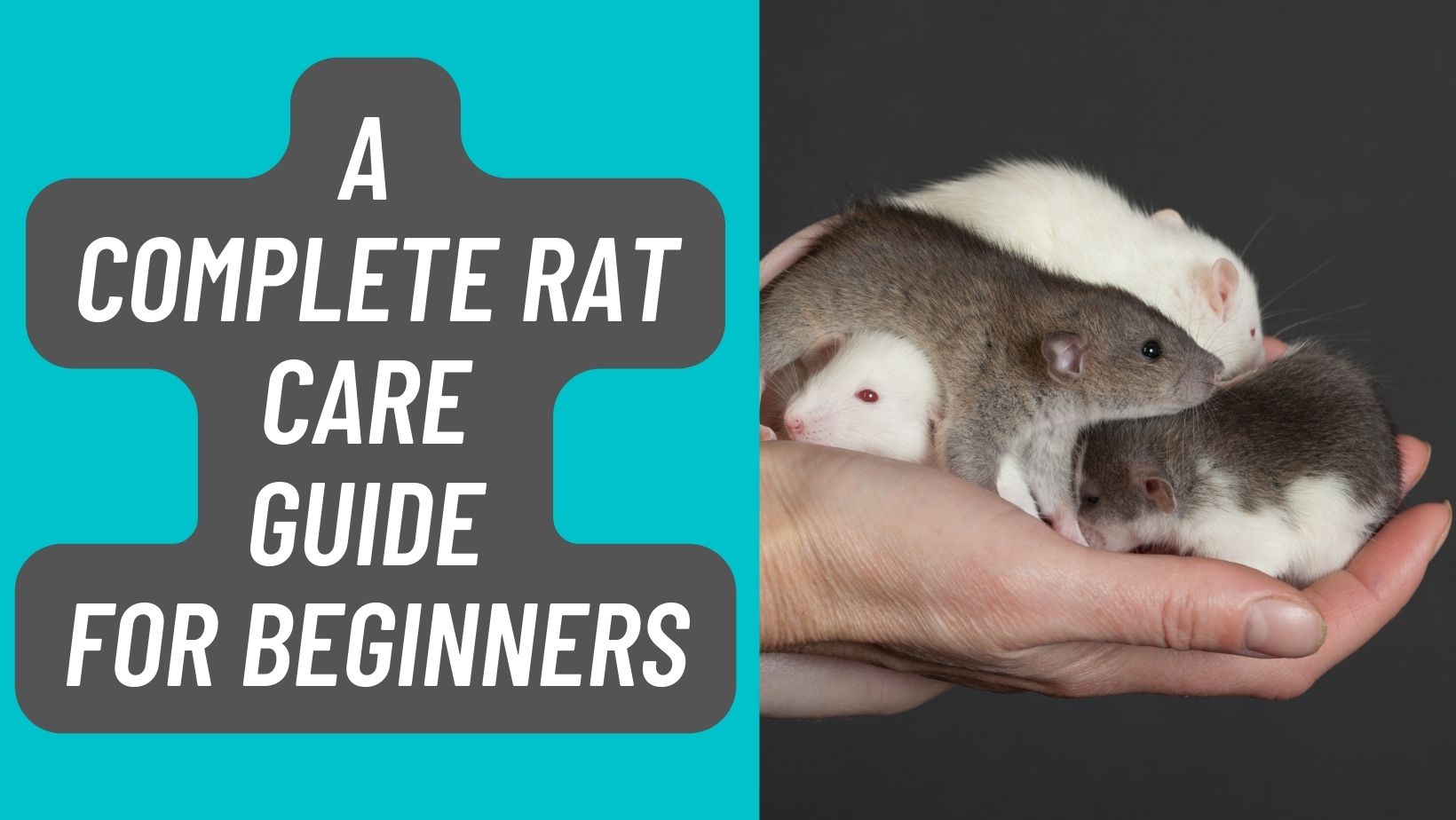Why Rats?
Rats make excellent pets for so many reasons. They are perfect for people who have limited space, and are relatively inexpensive to keep. Rats make good pets for older children, but it is important to buy your rats from a reputable breeder, who breeds good-natured rats.
Aggressiveness cannot be “bred out” of rats, so good breeders work to eliminate bad traits such as aggressiveness and biting.
These traits are rare in pet rats, but poor handling and mistreatment can make a rat timid or unfriendly. Rats are loyal, playful, affectionate, and each one has its own unique personality.
Rat Care Guide for Beginners- All You Need to Know
A lot of people will tell you that male rats cannot live together as they are aggressive, and will fight each other. This is NOT true. Rats will play-fight to assert their position in the “pecking order”, but this rarely causes injuries. Only occasionally will a rat be unable to live with others due to severe aggressive tendencies.
Male rats are actually very easy-going, lazy animals, who generally lie about in piles and sleep. If you want a rat to cuddle, choose a boy.
Female rats are smaller than the males, and could be described as bundles of energy that simply don’t have time to stop. Females are much more active than males, and do tend to chew things more.
They are generally more mischievous, and are always getting into trouble, climbing, hiding and jumping.
General care
To stay happy and healthy, rats need:
Food & water
Rats need access to fresh food and clean, cool water at all times. See the food page for more details.
Cages
Rats need room to climb, run and play. Litter areas should be kept separate from sleeping and eating areas. The cage should have adequate ventilation, and no sharp edges or places where a foot or head could get caught. Some litters are toxic and should not be used – see the cages page.
Always supervise playtime!
Play time
Rats need time out of their cages to play and socialise with their owners. This ensures that they aren’t bored, and keeps them healthy and happy. Rats love exploring, hiding and climbing. As long as they are supervised, rats should have at least an hour every day of “out time”.

It is important to move any electrical cords out of reach, and make sure that valuables are out of reach of ratty teeth.
Friends
One of the most important things about keeping rats is that you MUST have at least two (of the same sex). Rats are social animals, most active at night, when you are sleeping. If you only have one rat, then at nighttime they will have nobody to play with.
Even if you play with your rat all day, and give her lots of toys, she still needs a friend. Make sure you keep same-sex pairs though, keeping a male and a female together is an irresponsible breeding practice.
Two rats will not take up any more room that one rat, and the difference in food is minimal. Some people worry that if you have two rats, they will not bother with their owners as much, but this is not true. In fact, the opposite is true – rats that live in groups are happier and friendlier.
Remember too that it is a myth that male rats cannot live in colonies. Males are actually very lazy, easygoing, and quiet rats. They rarely fight, and if there is any squabbling going on, you can guarantee that it is the girls and not the boys.
The three bucks in this photo are inseparable buddies!
Feeding pet rats
- Dry food
Rats should always have access to dry food. Many people believe that rats can live on bird seed, and while they probably could, it’s not very healthy.
Typically, my dry food mix consists of:
| Parrot seed | Dry pasta |  Rat Care Guide! |
| Pepitas | Walnuts | |
| Puffed wheat | Weetbix | |
| Bran | Brown rice | |
| Dog biscuits | White rice | |
| Dried legumes | Barley | |
- Fresh food
Along with a constant supply of dry food, rats need fresh fruit and vegetables to stay healthy. In summer, give cooling, juicy foods, and in winter, give warm foods such as cooked rice and vegetables. Rats should be given the same amount of food at the same time each day.
I usually feed my rats later in the evening, because rats are most active at night, and that’s when they eat the most. Rat “dinners” might consist of:
|
|
“Desserts”
For dessert, I always give my rats soy milk – either plain, or mixed with fruit, yoghurt, baby cereal, or Weet-Bix. Soy products are thought to help prevent tumours. Soy milk, tofu, soy beans, soy yoghurt, soy custard and miso are all soy foods that rats love.
Soy milk is also high in protein, and helps to “fatten up” sick, old, or orphan rats.
Water
Rats should always have access to clean water. Glass or plastic water bottles are best, and must be scrubbed out every few days and refilled. Bottles are better than bowls, because they keep the water free of food, litter and waste.
Bowls can be easy to tip as well, leaving the rats with no water.
Treats
Some foods are best given only occasionally – they are the equivalent of human “junk food”. Dairy can cause upset stomachs, but rats love cheese, so a small amount every now and then is ok. Rats also love chocolate.
Although chocolate is toxic for dogs, it’s not toxic for rats – but it’s still not very healthy. Rats can get cavities in their back teeth, so avoid sugary foods. Boiled egg, sardines and oysters can be given with dinner, but don’t overdo it.
Peanut butter is another favourite, but rats can choke on it if they try to eat too much in one mouthful. Try smearing it thinly on bread, so that it isn’t thick and sticky.
Sheets of dried seaweed from the asian food section in the supermarket will also be gobbled up. Large chicken bones are great for rats – they spend time gnawing on them and trying to get the marrow out.
Anything green and juicy will impress a rat – try fresh mint leaves sprinkled over their dinner, or just as a treat during the day. Helps get rid of sardine or spaghetti breath!
The ultimate in ratty treats: avocado. Avocado is great for fattening up sick rats, and also excellent for disguising medications. Or, mash it up and spread over their dinner as a treat.
Foods to avoid
As a rule, rats will eat just about anything that smells interesting. It’s tempting to feed them “human food” like softdrink, chocolate, and fatty foods, but this can damage their health.
Rats can’t burp, so fizzy drinks should NEVER be given to them. Sticky foods such as peanut butter or lollies can cause rats to choke. Citrus fruits are thought to contribute to causing cancer in male rats, so it’s probably best to avoid them.
Rats can suffer similar health problems to humans if they are given too much fatty food, so limit fat in their diets as much as possible. Sunflower seeds, nuts, and meats are all quite high in fat.
They can be given occasionally, but not too often. Also, too much fat and protein can cause skin problems. As a general rule, the bulk of a rat’s diet should be 8% protein or less.
High-protein foods should be given occasionally, not every day.

Home Squeak Home
- Aquariums (large fish tanks)
Aquariums are an attractive way to house rats, because there are no cage bars to block the view. They are easy to clean – you just sponge them out with warm soapy water.
Aquariums do have the disadvantage of being poorly ventilated though – they need a wire lid (not glass!) to let the air in, and may not be suitable for warmer climates.
Because of this poor ventilation, they also need to be cleaned out more often.
Cages
Cages are a better option for warmer climates, allowing the breeze to flow through. Cages can either be bought as-is, although very few pet stores have cages that would be large enough for rats, or you can build them yourself.
The benefit of making your own cage is that you can make it to your own specifications, according to the room that you have available, how many rats you have etc.
Remember that rats will chew on wood, so if you use wood for the frame, be prepared for it to be gnawed on. Wire mesh should be small enough that the rats can’t get legs or heads stuck, and if you keep your rats outside, the mesh needs to be able to keep snakes and birds out.
Pet rats are *not* wild rats – they are not build to live outside in the elements. If you absolutely have to have them outside, make sure they are sheltered from the sun, wind and rain.
Mosquitoes and ants may pose a problem for outdoor rats. Keep the cages up on tables where possible, and either spray around the table legs, or scatter ant dust around (make sure none goes into the cages).
Mosquito coils and citronella candles can be used to keep insects away, but don’t put them too close to the cages, as rats have very sensitive noses.
Combo cages!
If you want the good looks, convenience, and insulation of the aquarium, but want to give your rats climbing space and a breezy place to sleep in summer, consider combining tanks and cages into one big combo cage.

By building a “cage topper” for your aquarium, you instantly have two levels for your rats to explore, and it allows them to choose whether they want to sleep downstairs where it is warm, or upstairs in the cool.
Toys and accessories
Rats love to play, so make sure that the cage has plenty of things for them to climb on and explore in. Here are a few ideas:
| Hammocks | Ladders |
| Plaited ropes | Scratching posts |
| PVC pipes and tubes | Parrot toys |
| Igloos | Cardboard boxes |
| Bricks | Rags |
| Chew toys | Paddlepop sticks |
| Catnip toys | Rat Care Guide! |
Most pet toys are suitable, but remember that rats love to chew, so make sure they have no pieces that could come off and cause the rats to choke.
- Litter and bedding
Some litter products can be harmful to rats. Pine shavings (soft wood) contain chemicals that can cause respiratory problems, and are best avoided. I use recycled paper litter, which is sold in supermarkets.
It isn’t as soft and fresh smelling as pine shavings, but the rats soon get used to it, it’s much better for them, and it makes good compost too.
Avoid clay kitty litter at all costs. If swallowed, clay litter naturally clumps together, forming a deadly lump in the rat’s stomach. If you want a litter that is similar to clay litter, but non-toxic, there is a product called Max’s, made from rice hulls.
Rats are very intelligent, and will automatically try to keep their toilet area away from their food and sleeping areas. Set up a kitty litter tray at one end of the cage, with Max’s litter in it, and use newspaper pellets for the rest of the cage.
Put the food bowl and sleeping area at the opposite end to the kitty litter tray. The rats will soon get used to using the kitty litter tray, so you will only need to empty the tray each day and not the entire cage.
This also means that you can put a kitty litter tray down on the floor when you let your rats free-range. If they are familiar with using the tray, they will actually run across the room to use it, rather than making a mess on the carpet!
I have seen one of my rats hop out of a hammock, walk down a ladder, across the cage, into the litter tray, use it, and then go back up to “bed”. Rats hate mess.
Breeding rats
Breeding rats is not just a case of putting a male in with a female. While there are many things you need to consider before breeding, I think there are 3 main rules:
Are the parents healthy, friendly, and free of problems?
You should never breed rats that are aggressive, unhealthy, or have any deformities such as odd-sized eyes, club feet, kinked tails etc. Only experienced breeders should breed manx and hairless rats, as they have special needs.
Aggression can never be “bred out” of rats, so even if you have a stunning rat with fantastic bloodlines, she shouldn’t be bred if she is known to be nasty to humans or other rats.
Will I have time to properly handle and socialise the babies?
Rats that are handled from birth are more comfortable with humans
If you are careful, you can handle baby rats from birth – just be careful to distract the mother first, as some mother rats can be very protective of their babies.
It is a myth that mother rats will kill and/or eat her babies if you get your smell on them. A mother rat will only do that if the baby has a severe deformity, is stillborn, or if she is so undernourished from the pregnancy that she is forced to eat the baby to save herself.
If you are able to distract the mother to handle the babies, it can be very beneficial.
By handling and playing with the babies, they will be used to humans from day one, and make much better pets. Rats that aren’t handled early, or are mishandled or hurt by humans, will either be very timid and frightened of humans, or may be aggressive.
Will I be able to find good homes for all of the babies?
This is VERY IMPORTANT. If you don’t know where you will home your babies, or you assume that you can send them to the local pet store,
DON’T BREED RATS.
When I breed my rats, I always make sure that people want the babies first. I will always have several people waiting for my babies at one time. If I can’t home all of them, then I am prepared to keep the rest – I am a responsible breeder.
I won’t send my babies off to bad homes, and I don’t send them to pet stores.
Pet stores, although it is illegal, DO SELL BABY RATS FOR SNAKE FOOD.
Even if the pet store is responsible, and refuses to sell rats for snake food, snake owners can easily pretend to want to buy a rat as a pet, and get away with it. “Live feeding” is illegal in Australia, but it still happens. I refuse to let my babies become food.
Remember, breeding rats is not something that you do for fun. It needs careful planning, and a lot of work.





